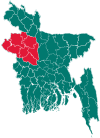Charghat Upazila
Charghat
চারঘাট | |
|---|---|
Upazila | |
 Charghat Location in Bangladesh | |
| Coordinates: 24°17′N 88°46.5′E / 24.283°N 88.7750°ECoordinates: 24°17′N 88°46.5′E / 24.283°N 88.7750°E | |
| Country | |
| Division | Rajshahi Division |
| District | Rajshahi District |
| Government | |
| • MP (Rajshahi-6) | Shahriar Alam |
| • Upazila Chairman | Muhammad Faqrul Islam |
| Area | |
| • Total | 164.52 km2 (63.52 sq mi) |
| Population (1991) | |
| • Total | 163,862 |
| • Density | 996/km2 (2,580/sq mi) |
| Time zone | UTC+6 (BST) |
| Website | http://charghat.rajshahi.gov.bd |
Charghat (Bengali: চারঘাট) is an Upazila of Rajshahi District in the Division of Rajshahi, Bangladesh.[1]
Background[]
Charghat is on the bank of the river Padma. There is the only Police Academy at Sardah & a cadet college. Charghat was declared Pourashava in 1998. Md. Anwar Hossain was the first chairman. Charghat is famous for Khoer industry. Mangoes are produced here in plenty. The noted villages of Charghat are Gopalpur, Charghat, Miapur, Babupara, Kakramari, Pirojpur, Sardah and Mokterpur. A sand mine is located here. Rajshahi Cadet College is situated here. There is a club named Mokterpur Shobuj Shangha. A charity organization named BOTBRIKKHO is also there which works for the poor people. It was established by Md. Oashimul Bari (Oashim), a student of Dhaka University, Dept. of English. Charghat is a centre of cultural programs. Padma Boral Theatre, Projonmo Theatre of Dakra & Botbrikkho are at the helm of arranging the programs. Sports are held here frequently. All these are supervised by the honourable Mp Md. Shahriar Alam MP. Sardah Govt. Pilot High School, Padma High School, Charghat High School, Charghat M.A. Hadi College and Shardah college are the top level one in Charghat Upazila.
Geography[]
Charghat is located at 24°17′00″N 88°46′30″E / 24.2833°N 88.7750°E. It has 30799 households and total area 164.52 km2.
Charghat Upazila is bounded by Puthia and Paba Upazilas on the north, Bagatipara Upazila in Natore District and Bagha Upazila on the east, Bagha Upazila in the south and Raninagar II and Jalangi CD Blocks, in Murshidabad district, West Bengal, India, across the Ganges/ Padma, on the west.[2][3]
Demographics[]
According to 2011 Bangladesh census, Charghat had a population of 206,788. Males constituted 50.36% of the population and females 49.64%. Muslims formed 95.82% of the population, Hindus 4.04%, Christians 0.04% and others 0.11%. Charghat had a literacy rate of 47.68% for the population 7 years and above.[4]
As of the 1991 Bangladesh census, Charghat has a population of 163862. Males constitute 51.62% of the population, and females 48.38%. This Upazila's eighteen up population is 82597. Charghat has an average literacy rate of 26.6% (7+ years), and the national average of 32.4% literate.[5]
Administration[]
Charghat Upazila is divided into Charghat Municipality, and six union parishads: Bhaya Lakshmipur, Charghat, Nimpara, Salua, Sardah, and Yusufpur. The union parishads are subdivided into 93 mauzas and 115 villages.[6]
Education[]
According to Banglapedia, Sardah Government Pilot High School, founded in 1916, is a notable secondary school.[1]
See also[]
- Upazilas of Bangladesh
- Districts of Bangladesh
- Divisions of Bangladesh
References[]
- ^ Jump up to: a b Alam, Md Jaidul (2012). "Charghat Upazila". In Islam, Sirajul; Jamal, Ahmed A. (eds.). Banglapedia: National Encyclopedia of Bangladesh (Second ed.). Asiatic Society of Bangladesh.
- ^ "Paba Upazila". Banglapedia. Retrieved 15 November 2018.
- ^ "Tehsil Map of Murshidabad". CD Block/ Tehsil. Maps of India. Retrieved 15 November 2018.
- ^ "Bangladesh Population and Housing Census 2011: Zila Report – Rajshahi" (PDF). Table P01 : Household and Population by Sex and Residence, Table P05 : Population by Religion, Age group and Residence, Table P09 : Literacy of Population 7 Years & Above by Religion, Sex and Residence. Bangladesh Bureau of Statistics (BBS), Ministry of Planning, Government of the People’s Republic of Bangladesh. Retrieved 9 December 2018.
- ^ "Population Census Wing, BBS". Archived from the original on 2005-03-27. Retrieved November 10, 2006.
- ^ "District Statistics 2011: Rajshahi" (PDF). Bangladesh Bureau of Statistics. Archived from the original (PDF) on 13 November 2014. Retrieved 14 July 2014.
- Upazilas of Rajshahi District
- Rajshahi Division geography stubs

